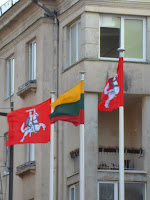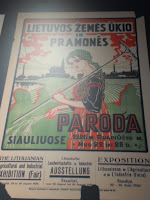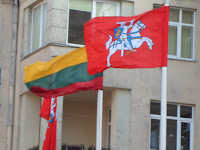ESTIJAI 100: SU ŠIMTMEČIU!
ESTLAND 100! GRATULIERUNG!
ESTONIA 100! CONGRATULATIONS!
24 FEBRUARY, 2018
Today, Estonia celebrates the 100th Anniversary of its Independence!
Congratulations from Lithuania, where the 100th Anniversary of the restored
Independence was celebrated a week ago.*
Interested? Please, read more - English texts are blue.
*Read more: http://nijolife.blogspot.lt/2018/02/2018-lietuva100lithuania100litauen.html
DER 24. FEBRUAR 2018
Heute feiert Estland sein 100. Jubiläum der Unabhängigkeit.
Viele schöne Grüße von Litauen, das sein 100. Jubiläum
vor einer Woche gefeiert hat.*
Interessant? S. bitte weiter - deutsches Info in Rot.
*S. mehr: http://nijolife.blogspot.lt/2018/02/2018-lietuva100lithuania100litauen.html
2018 VASARIO 24
Šiandien Estijos nepriklausomybei - 100 metų!
Geriausi linkėjimai Šimtmečio proga nuo Lietuvos, prieš savaitę
atšventusios savo Šimtmetį.*
Įdomu? Žr. toliau - lietuviški tekstai juoda spalva.
*Žr. daugiau: http://nijolife.blogspot.lt/2018/02/2018-lietuva100lithuania100litauen.html
THE 100TH ANNIVERSARY OF ESTONIA IN ŠIAULIAI
You can celebrate the 100th Anniversary of Estonia in Šiauliai, in the fourth largest city
of Lithuania, too. In the main street of the city, the Estonian flags fluttered in the wind every
100 metres. In Cafes, you can taste the famous Estonian liqueur 'Vana Tallinn'. And in museums,
as well as in exhibition halls, you can discover works of Estonian visual artists. Even in the Šiauliai Cat Museum, there's something from Estonia: a small wonderful cat!
DAS 100. JUBILÄUM ESTLANDS IN ŠIAULIAI
Das 100. Jubiläum Estlands kann man auch in Šiauliai, in der viertgrößten Stadt
Litauens, feiern. In der Hauptstraße der Stadt sieht man estnische Fahnen fast je 100 Meter wehen. In Cafés kann man den berühmten estnischen Likör "Vana Tallinn" probieren. Und in Museen und Ausstellungshallen sind Werke estnischer Künstler zu besichtigen. Sogar im Katzenmuseum hat man einen Gast aus Estland: da "miaut"
ein sympathisches estnisches Kätzchen!
ESTIJOS ŠIMTMETIS ŠIAULIUOSE
Estijos šimtmetį galima švęsti ir Šiauliuose. Miesto centrinėje gatvėje
kas 100 metrų plevėsuoja Estijos valstybinės vėliavos. Kavinėse visur galima paragauti
garsiojo estiško likerio "Vana Tallinn", muziejuose ar parodų salėse tikrai gausu Estijos
menininkų darbų. Net Šiaulių Kačių muziejuje "miauksi" miniatiūrinis
kačiukas iš Estijos.
THE 100TH ANNIVERSARY OF ESTONIA IN ESTONIA
And how does celebrate Estonia itself? Let's ask Google about it!
It isn't a coincidence, that today, Google is dyed blue. It's one of the colours of Estonian
national flag. Estonia celebrates with great refinement! The country will celebrate
its 100th Anniversary all the year and invite all to visit it.
I have been often in Estonia, and the last time, it was... Let's count! O, God, it was
10 years ago! It's high time to visit Estonia again, isn't it?
So, let's wait for new Estonian impressions!
DAS 100. JUBILÄUM ESTLANDS IN ESTLAND
Und wie feiert Estland selbst? Lasst uns fragen darüber Google,
das sich heute nicht zufällig blau gefärbt hat. Blau ist eine der Farben von der estnischen Nationalflagge. Ja, Estland feiert richtig raffiniert! Das Land wird sein Jubiläum
das ganze Jahr feiern und lädt ein, es zu besuchen.
Ich bin in Estland oft gewesen, das letzte Mal war es... Lasst uns rechnen! O, Gott, es war
vor 10 Jahren! Es ist die höchste Zeit, Estland wieder zu besuchen, oder?
Also, wartet auf estniche Eindrücke!
ESTIJOS ŠIMTMETIS ESTIJOJE
O kaip švenčia pati Estija? Šiais laikais galima sužinoti bet ką iš bet kur,
kur yra internetas. Atsiverčiame Google - šis šiandien irgi švyti estiškomis spalvomis.
Taip, Estija švenčia rafinuotai. Šalis švęs savo Šimtmetį visus metus ir kviečia apsilankyti.
Estijoje buvau daug kartų, paskutinį kartą... Paskaičiuokim! O, Dieve, gal prieš 10 metų!
Pats laikas vėl apsilankyti. Taigi, laukite estiškų žinių!
HAPPY ANNIVERSARY YEAR, ESTONIA!
SCHÖNES UND FROHES JUBILÄUMSJAHR, ESTLAND!
GRAŽIŲ IR SMAGIŲ ŠIMTMEČIO METŲ, ESTIJA!
nijo.life@gmail.com
 |
| ESTIJAI 100! ESTONIA- 100! ESTLAND - 100! |
24 FEBRUARY, 2018
Today, Estonia celebrates the 100th Anniversary of its Independence!
Congratulations from Lithuania, where the 100th Anniversary of the restored
Independence was celebrated a week ago.*
Interested? Please, read more - English texts are blue.
*Read more: http://nijolife.blogspot.lt/2018/02/2018-lietuva100lithuania100litauen.html
DER 24. FEBRUAR 2018
Heute feiert Estland sein 100. Jubiläum der Unabhängigkeit.
Viele schöne Grüße von Litauen, das sein 100. Jubiläum
vor einer Woche gefeiert hat.*
Interessant? S. bitte weiter - deutsches Info in Rot.
*S. mehr: http://nijolife.blogspot.lt/2018/02/2018-lietuva100lithuania100litauen.html
2018 VASARIO 24
Šiandien Estijos nepriklausomybei - 100 metų!
Geriausi linkėjimai Šimtmečio proga nuo Lietuvos, prieš savaitę
atšventusios savo Šimtmetį.*
Įdomu? Žr. toliau - lietuviški tekstai juoda spalva.
*Žr. daugiau: http://nijolife.blogspot.lt/2018/02/2018-lietuva100lithuania100litauen.html
 | ||
| ŠIAULIAI (LITHUANIA): KAČIŲ MUZIEJUS * THE CAT'S MUSEUM "Esu iš Estijos!" * "I am from Estonia!" |
THE 100TH ANNIVERSARY OF ESTONIA IN ŠIAULIAI
You can celebrate the 100th Anniversary of Estonia in Šiauliai, in the fourth largest city
of Lithuania, too. In the main street of the city, the Estonian flags fluttered in the wind every
100 metres. In Cafes, you can taste the famous Estonian liqueur 'Vana Tallinn'. And in museums,
as well as in exhibition halls, you can discover works of Estonian visual artists. Even in the Šiauliai Cat Museum, there's something from Estonia: a small wonderful cat!
DAS 100. JUBILÄUM ESTLANDS IN ŠIAULIAI
Das 100. Jubiläum Estlands kann man auch in Šiauliai, in der viertgrößten Stadt
Litauens, feiern. In der Hauptstraße der Stadt sieht man estnische Fahnen fast je 100 Meter wehen. In Cafés kann man den berühmten estnischen Likör "Vana Tallinn" probieren. Und in Museen und Ausstellungshallen sind Werke estnischer Künstler zu besichtigen. Sogar im Katzenmuseum hat man einen Gast aus Estland: da "miaut"
ein sympathisches estnisches Kätzchen!
ESTIJOS ŠIMTMETIS ŠIAULIUOSE
Estijos šimtmetį galima švęsti ir Šiauliuose. Miesto centrinėje gatvėje
kas 100 metrų plevėsuoja Estijos valstybinės vėliavos. Kavinėse visur galima paragauti
garsiojo estiško likerio "Vana Tallinn", muziejuose ar parodų salėse tikrai gausu Estijos
menininkų darbų. Net Šiaulių Kačių muziejuje "miauksi" miniatiūrinis
kačiukas iš Estijos.
 |
| 24.2.2018 * GOOGLE * 2018.2.24 Google, nusidažęs estiška mėlyna spalva * Google, dyed in Estonian colour - blue |
THE 100TH ANNIVERSARY OF ESTONIA IN ESTONIA
And how does celebrate Estonia itself? Let's ask Google about it!
It isn't a coincidence, that today, Google is dyed blue. It's one of the colours of Estonian
national flag. Estonia celebrates with great refinement! The country will celebrate
its 100th Anniversary all the year and invite all to visit it.
I have been often in Estonia, and the last time, it was... Let's count! O, God, it was
10 years ago! It's high time to visit Estonia again, isn't it?
So, let's wait for new Estonian impressions!
DAS 100. JUBILÄUM ESTLANDS IN ESTLAND
Und wie feiert Estland selbst? Lasst uns fragen darüber Google,
das sich heute nicht zufällig blau gefärbt hat. Blau ist eine der Farben von der estnischen Nationalflagge. Ja, Estland feiert richtig raffiniert! Das Land wird sein Jubiläum
das ganze Jahr feiern und lädt ein, es zu besuchen.
Ich bin in Estland oft gewesen, das letzte Mal war es... Lasst uns rechnen! O, Gott, es war
vor 10 Jahren! Es ist die höchste Zeit, Estland wieder zu besuchen, oder?
Also, wartet auf estniche Eindrücke!
ESTIJOS ŠIMTMETIS ESTIJOJE
O kaip švenčia pati Estija? Šiais laikais galima sužinoti bet ką iš bet kur,
kur yra internetas. Atsiverčiame Google - šis šiandien irgi švyti estiškomis spalvomis.
Taip, Estija švenčia rafinuotai. Šalis švęs savo Šimtmetį visus metus ir kviečia apsilankyti.
Estijoje buvau daug kartų, paskutinį kartą... Paskaičiuokim! O, Dieve, gal prieš 10 metų!
Pats laikas vėl apsilankyti. Taigi, laukite estiškų žinių!
 |
| Pirmas iš kairės: "Vana
Tallinn" (Estija) * The first one on the left (Estonia); "Rīgas balzams" (Latvija/Latvia), "Trejos devynerios" (Lietuva/Lithuania) |
HAPPY ANNIVERSARY YEAR, ESTONIA!
SCHÖNES UND FROHES JUBILÄUMSJAHR, ESTLAND!
GRAŽIŲ IR SMAGIŲ ŠIMTMEČIO METŲ, ESTIJA!
nijo.life@gmail.com






















































